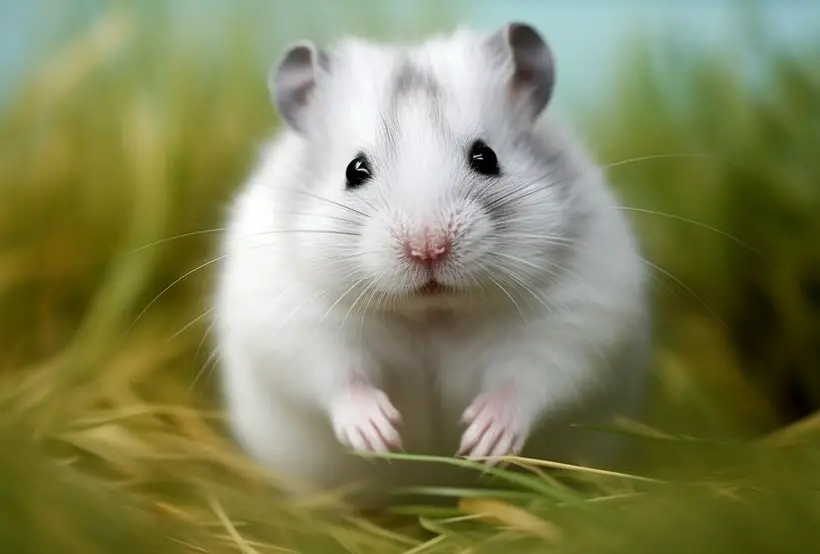Winter White Dwarf Hamster Lifespan: A Comprehensive Guide
Did you know that Winter White Dwarf hamsters (Djungarian) live as little as one year in the wild? This may drive some to rethink the idea of adopting Winter Whites as pets considering their short life. But not so fast – these rodents can keep you company much longer in captivity.
So, what’s the winter white dwarf hamster lifespan as a pet? A purebred winter white hamster will live for an average of 1.5 to 2.5 years. Hybrids, on the other hand, have shorter lifespans of 1 to 1.5 years. However, these averages can be longer with proper pet care and diet.
Let’s look deeper into winter white hamster lifespan, including the life cycle and factors that affect their life expectancy. Plus, we’ll share how to maximize the lifespan of these rodents so that you can spend even more time with them.
Winter White Dwarf Hamster Lifespan In Captivity

| Winter White Breed | Typical Life Span |
|---|---|
| Pure breed Winter White | 1.5-2.5 years |
| Hybrid Winter White Russian | 1-1.5 years |
Between the Syrian, Winter White, Campbell, Roborovski, and Chinese hamster breeds, only two can mate successfully. And that’s the Winter Whites and the Campbell’s dwarf. This brings forth two hybrid species, the Campbell’s Russian Dwarfs and the Winter White Russian Dwarfs.
- Genetics largely affects the lifespan of your Winter White hamster.
- So, you should be looking at what breed of winter white you have in the first place. Is it a pure Winter White or a hybrid Winter White Russian Dwarf? For pure breeds, you’re looking at 1.5 to 2.5 years compared to 1 to 1.5 years for hybrids.
- Hybrids are largely prone to diabetes, hence the reason for their short lifespan.
- They typically need a low-carb, low-fat, sugar-free diet to lead a healthy life.
- Apart from genetics, it might interest you to know that the reproductive activity of your Winter White may also affect its lifespan. A study on reproduction and longevity of dwarf hamsters and moles shows a positive connection between lifespan and the age at which your hamster had its first and last litter.
- Typically, females with more reproductive levels tend to live longer. Consistent food sources, medical care, fewer environmental risks, and a lack of predators are the main reasons for their longer lifespan in captivity.
Still, various factors, primarily diet, exercise, and overall pet care, will determine how long your hamster lives.
Winter White Hamster Life Cycle

What are the life stages of Winter Whites? Let’s first look at this life stage chart to understand better.
| Age | Life Stage |
|---|---|
| 0 | Birth |
| 18 to 21 days | Weaning |
| 4 to 5 weeks (female) | Sexual maturity |
| 3 to 4 weeks (Male) | |
| 3 months | Adulthood |
| From 12 months | Senior years |
Note that females can reach sexual maturity in 4 to 5 weeks. However, they should not be bred until 3-4 months to prevent stillbirth. During the 4-5 week period, the hip bones will be fusing, making it difficult for the mother to give birth naturally.
Winter Whites will be pregnant for 18-21 days, giving birth to around 4 to 6 pups. However, larger litters are quite common.
Essentially, your pet should be able to get pregnant after 24 hours of giving birth. Nevertheless, ensure to space the litter 3 months apart for healthy young offspring.
Health Conditions That May Shorten Their Lifespan

General hamster diseases are:
- Respiratory infections
- Skin infections (skin abscesses)
- Diarrhea (sometimes called the wet tail)
- UTI (urinary tract infections)
According to a study on mortality and disorders in pet hamsters, the wet tail disorder has the highest mortality rate. Diabetes is another disease that manifests more in hybrid Winter Whites due to their genetic makeup.
How To Improve Winter White Dwarf Hamster Lifespan?
How do you ensure your Winter White hamster lives longer? Generally, the answer lies with proper diet, hygiene, exercise, and regular vet care. Also, choose a pure breed.

Buy a pure breed
The most important factor pet owners forget is the breed. As we discussed earlier, hybrids tend to have a shorter life span. But how can you be sure you’ve got a purebred Winter White?
- One way to be sure is to buy it from reputable breeders who put health above everything else. Such breeders will often cut out Winter Whites that show genetic health problems.
Yes, it will fetch you a higher price than those on sale from hobby breeders and pet stores. However, you’re guaranteed to get a pure breed.
- Though it’s difficult to spot a hybrid, you can often tell them part by the body shape and color. For instance, it may have the body shape of a Campbell’s dwarf and the color of a purebred Djungarian (Winter White) hamster.
Provide a healthy balanced diet

Most Winter Whites typically live on pellets.
- However, for a healthier pet, incorporate fresh vegetables, including carrots, greens, and broccoli. In fact, vegetables are a great start to their diet.
- While at it, ensure to avoid fatty foods. According to a study on the biology and diseases of hamsters, feeding your hamster a diet of 15% of fat for three weeks induces diabetes.
- Also, ensure your Winter White has access to fresh water.
Provide mental and physical stimulation
Winter White dwarfs are playful, energetic, and active.
- Therefore, provide interactive toys like climbing ladders, tunnels, obstacle courses, and hamster wheels to accommodate their active lifestyle.
- Also, provide plenty of cage space, at least 450 square inches.
Maintain a hygienic environment

- Clean your pet’s cage by removing droppings and replacing bedding material one or more times a week.
- Also, check and remove any uneaten food as hamsters tend to hide food in the bedding material.
- While at it, ensure to wear gloves since your pet may be a carrier of bacteria, such as salmonella.
Go for vet checkups
Hamsters, including Winter Whites, require vet checkups 1-2 times a year. These routine checkups will help uncover and treat diseases. Also, you’re more likely to get nutritional advice from your vet.
If you’re interested in learning more about hamster lifespans, you might find our articles on Teddy Bear hamster lifespan and Russian Dwarf hamster lifespan helpful. Our article on Teddy Bear hamster lifespan provides information about the average lifespan and factors that can affect the longevity of these adorable hamsters. Similarly, our article on Russian Dwarf hamster lifespan explores the lifespan of this popular hamster breed and provides insights into their care and longevity. By exploring these articles, you’ll gain a better understanding of the lifespans and care requirements of different hamster breeds.FAQs
Let’s look at some related questions and answers on Winter White dwarf hamster life span.
Q. How big do Winter Whites get?
A fully grown adult is 3-4 inches long and weighs 1-2 ounces. Male Winter Whites are generally larger than females.

Q. What are the signs of aging in Winter White hamsters?
Your hamster will become slower and less active. Their coat will typically dull and the skin will show under it due to hair loss. Other signs include weight loss, vision problems, decreased appetite, and crooked or overgrown teeth.
Q. What is the best age to buy a Winter White dwarf hamster?
Buy your hamster at 5 weeks. Winter Whites are typically weaned at 3 weeks old. Allow 2 weeks more for the juvenile hamsters to get stronger.
Conclusion
To wrap it up, a Winter White dwarf hamster life span averages 1.5 to 2.5 years provided it’s a pure breed. However, you can add a few more months to this small size rodent with proper care, exercise, and diet.
Likewise, to many pet owners, this life expectancy may not be long as for other pets. Nevertheless, it’s still perfect for pet owners who are not looking for a long-term commitment.




